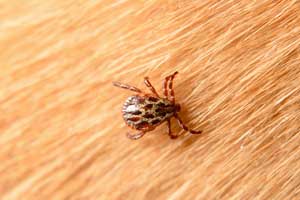 Get Rid of Fleas & Ticks
Get Rid of Fleas & Ticks
Serving Chicago Illinois and Indiana
Are your pets scratching endlessly? Are you starting to get itchy red bites yourself? If so, you probably want to know how to get rid of fleas and ticks. It’s a good question and there are many possible solutions, but first, it’s important to understand where they’re coming from. This can be any number of places, but there are three main areas you should focus on. To get rid of fleas and ticks, you must eliminate them from all of these areas simultaneously:
- Your pets
- Your yard
- Your carpets and bedding
If you don’t get rid of fleas and ticks in all these areas, re-infestations are almost guaranteed. Getting rid of fleas and ticks can require persistence and patience, but tackling all three areas at once is your best bet for lasting results. Often, hiring a flea and tick exterminator will be the most effective solution.
Let’s dive into the specifics of getting rid of fleas and ticks from your home and pets.
Where Do You Find Fleas and Ticks?
Many people treat their pet for fleas and ticks and assume it will solve the problem, but will it? Probably not. Ask yourself, Where did my pet get these from? And, how do I make sure they don’t get them again? In order to get rid of fleas and ticks, you need to get rid of them on your pet and get rid of them everywhere else your pet could get them.
That means you need to eliminate them from these three places:
- Your pet(s): When fleas and ticks find their way onto your pets, your pet becomes their new permanent residence. Fortunately, there are some highly effective pet treatments to eliminate them. You can order them online or from a pet store, but if you’ve never tried them before, it’s best to ask your veterinarian for recommendations or a prescription.
- Your yard: Many homeowners have flea and tick infestations in their yards without realizing it. You can use store-bought products to treat fleas and ticks in your yard, but they’re not always effective, and the infestations can be challenging to pinpoint. Professional flea and tick control yard treatments are far more effective than DIY.
- Your home (especially your carpet and bedding): Does your pet have a bed or favorite place to rest during the day? It may be littered with fleas and flea eggs. Be sure to wash pet bedding regularly, or your own bedding if pets sleep on the bed. You should also vacuum your carpet regularly and empty the contents outside.
How to Get Rid of Fleas and Ticks on Your Pet
Watching your pet scratch itself as fleas and ticks slowly drive them crazy can be heartbreaking as a pet owner. To protect your pets from parasitic pests like fleas and ticks, here are some things you can do:
- Watch for signs of flea and tick activity: “Flea dirt” is brown and resembles actual dirt in your pet’s fur. While it’s brown in color, it isn’t dirt at all – it’s actually flea feces. Another sign of fleas and ticks is frequent scratching. If you notice either of these signs or small raised bumps or scabs on your pet, they might have fleas or ticks. For more information, check out our article on the signs of fleas and ticks.
- Take your pets to the vet: Your veterinarian can give you safe flea control products that will protect your dogs and cats, effectively keeping them out of your house!
- Start them on a regular flea and tick treatment: Topical treatments, collars, and supplements can all be effective and you can purchase them online. Once you start them on the program, stick with it – it probably won’t be immediately effective, but they will make gradual progress.
- Flea baths if necessary: If your flea and tick treatments aren’t working immediately, consider giving them a flea bath for more immediate protection.
- Groom them regularly: Keeping your pet’s hair short and brushing them regularly gives fleas and ticks less space to hide, and makes it more likely you’ll spot them sooner.
- Learn how to safely remove ticks: Found a tick on your dog? It’s important to know how to remove ticks safely.
Ready For a Free Flea or Tick Control Quote?
Click the button below to leave your information and we’ll be in touch with a fast flea or tick control quote!
How to Get Rid of Ticks and Fleas in Your Yard
If there are fleas and ticks in your yard, it’s much more likely they’ll eventually make their way inside, either on your pet or some other pest like a rat, mouse, or bird that wanders in. Here’s how you can eliminate fleas and ticks in your yard:
- Identify potential problem areas: Fleas and ticks thrive in shaded, moist spots with organic debris. Pay special attention to areas under decks, porches, trees, and shrubs, as well as anywhere your pets spend time like dog runs or favorite resting spots.
- Keep your landscaping neat and tidy: When you keep your lawn neat and trimmed, there are fewer areas for fleas and ticks to hide, and with less shade, you’ll force them to go elsewhere.
- Apply targeted treatment: Once you know where fleas and ticks are located in your yard, what’s next? You may want to try store-bought treatment. Just beware that DIY flea and tick treatment often misses areas, meaning it’s a matter of time before they’re back.
- Professional flea and tick control treatment: Treating your yard for fleas and ticks is one of the most challenging aspects of eliminating an infestation. If you want to save yourself some aggravation, you should absolutely hire an expert for flea and tick yard treatment. A trained exterminator can come to your property equipped with the expertise and tools to do the job right.
How to Get rid of Fleas and Ticks in Your Home
Last but not least, the interior of your home. If your pets have been dealing with fleas or ticks, it’s likely that they’ve established themselves somewhere (or more than one place) inside your house. Here’s what you can do to eliminate fleas and ticks inside:
- Start with thorough vacuuming, which is surprisingly effective: Vacuum all carpets, rugs, upholstery, pet bedding, and cracks between floorboards. Pay special attention to areas where your pets spend time and high-traffic zones. The vibration actually stimulates flea eggs to hatch, exposing them to treatment. Dispose of vacuum bags immediately or empty bagless canisters into sealed bags.
- Wash everything washable in hot water (at least 140°F): This includes pet bedding, your own bedding, curtains, and any fabric items that may have contacted pets. The heat kills all life stages of fleas.
- Treat carpets and upholstery with products specifically designed for indoor flea control: Look for sprays containing methoprene or pyriproxyfen, which prevent flea larvae from developing. Some people use diatomaceous earth (food grade), though it can be messy and needs time to work.
- Address pet sleeping areas thoroughly since this is where flea eggs concentrate: Consider replacing heavily infested pet bedding entirely.
- Keep humidity below 50% if possible: Fleas need moisture to survive. Use dehumidifiers or increase ventilation to make conditions more hostile to them.
- Be patient and persistent: You may see fleas for a month or two weeks after treatment begins as eggs continue hatching. This is completely normal and it doesn’t mean your treatment failed. Continue diligently treating your pet, your yard, and your home.
- For ticks, focus on washing and drying clothing and bedding on high heat: Ticks are less likely to establish themselves indoors but can hide in fabric items.
Can You Eliminate Fleas and Ticks All Naturally?
Getting rid of fleas and ticks from your pets, your yard, and your home’s interior is tricky – especially when you’re trying to do all three of those at the same time. Relying on all-natural products only makes it even more difficult – and some might say impossible.
Consider using all-natural products as a supplement to your flea and tick control, but don’t use it as the only means, or you may soon find the problem spiraling out of control.
- Essential oils: You can try using essential oils like a sprayable flea and tick product, but be careful not to spray too much or use them on your pets as they may be toxic.
- Diatomaceous earth: Sprinkle a little bit in areas that may be harboring fleas. It will dehydrate some fleas and cause them to die when they come in contact with it.
- Bathing and combing pets: Regularly bathing and grooming your pet can remove living fleas and ticks and reduce the immediate problem.
- Nematodes: These tiny organisms feast on flea larvae, so you can reduce the problem by placing them strategically in your yard.
- Cedar chips: Create a no-tick border by placing cedar chips. Ticks are repelled by them and won’t venture into them.
- Keep your lawn manicured: Fleas and ticks crave shade and moisture, and a short, well-kept lawn makes it much harder for them to survive.
- Vacuuming carpet and washing bedding: These actions physically remove fleas and ticks from areas they might be living, making it an effective strategy to go along with other more targeted treatments. When washing bedding, be sure to use hot water.
For more information, check out our article on flea and tick prevention.
Think you might need professional help for your flea and tick problem? Give us a call!
Professional Fleas and Ticks Treatment in Illinois
If you have been trying to get rid of fleas and ticks to no avail, you can always count on your local flea and tick exterminator at Terminix Anderson. Our experts can assess your situation and set up a treatment for fleas and ticks that suits all of your needs.
For more advice on getting rid of ticks in your yard or fleas on your pets, contact us today!



